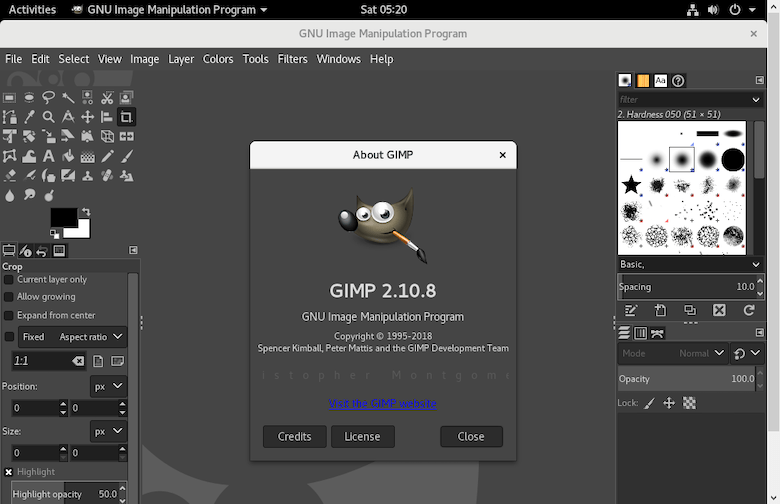How To Install GIMP on Fedora 40

In this tutorial, we will show you how to install GIMP on Fedora 40. GIMP (GNU Image Manipulation Program) is a powerful, open-source image editing software that has been a go-to choice for Linux users for decades. With its extensive set of tools and features, GIMP offers a versatile solution for both beginners and advanced users looking to edit, manipulate, and enhance their images. The release of Fedora 40, the latest version of the popular Linux distribution, has brought excitement to the community, and many users are eager to install GIMP on their updated systems.
This article assumes you have at least basic knowledge of Linux, know how to use the shell, and most importantly, you host your site on your own VPS. The installation is quite simple and assumes you are running in the root account, if not you may need to add ‘sudo‘ to the commands to get root privileges. I will show you the step-by-step installation of the GIMP image editor on Fedora 40.
Prerequisites
Before we dive into the installation process, ensure that you have the following prerequisites in place:
- A server running one of the following operating systems: Fedora 40.
- It’s recommended that you use a fresh OS install to prevent any potential issues.
- You will need access to the terminal to execute commands. Fedora provides the Terminal application for this purpose. It can be found in your Applications menu.
- A stable internet connection to download the necessary packages.
- A non-root sudo user or access to the root user. We recommend acting as a non-root sudo user, however, as you can harm your system if you’re not careful when acting as the root.
Install GIMP on Fedora 40
Step 1. Update the System.
Before diving into the installation process, it’s crucial to ensure that your Fedora 40 system is up to date. Updating your system helps to maintain stability, security, and compatibility with the latest software packages. To update your Fedora 40 system, open the terminal and run the following command:
sudo dnf clean all sudo dnf update
This command will fetch the latest package information and prompt you to confirm the installation of any available updates. Once the update process is complete, your system will be ready for GIMP installation.
Step 2. Installing GIMP on Fedora 40.
- Installing GIMP on Fedora 40 Using DNF Package Manager
DNF (Dandified YUM) is the default package manager in Fedora 40, providing a simple and efficient way to install software packages. To install GIMP using DNF, follow these steps:
sudo dnf install gimp
DNF will resolve any dependencies and prompt you to confirm the installation. Press “Y” and hit Enter to proceed.
Once the installation is finished, you can launch GIMP from the Applications menu or by typing “gimp” in the terminal.
- Installing GIMP on Fedora 40 Using Flatpak
Flatpak is a popular package management system that allows users to install and run applications in a sandboxed environment, ensuring better security and portability across different Linux distributions. To install GIMP using Flatpak on Fedora 40, follow these steps:
sudo dnf install flatpak
Add the Flathub repository, which hosts a wide range of Flatpak applications, including GIMP:
flatpak remote-add --if-not-exists flathub https://flathub.org/repo/flathub.flatpakrepo
Install GIMP using the Flatpak command:
flatpak install flathub org.gimp.GIMP
Once the installation is complete, you can launch GIMP from the Applications menu or by running the following command in the terminal:
flatpak run org.gimp.GIMP

Using Flatpak to install GIMP provides an additional layer of isolation and security, as the application runs in a contained environment separate from the host system.
Step 3. Troubleshooting Common Installation Issues.
While the installation process of GIMP on Fedora 40 is generally straightforward, you may encounter some common issues. Here are a few troubleshooting tips:
- Dependency Issues: If you encounter dependency-related errors during the installation, ensure that your system is up to date by running “
sudo dnf update” and then retry the installation command. - Flatpak Issues: If you face problems while installing GIMP using Flatpak, make sure that you have added the Flathub repository correctly and that your system has the necessary permissions to install and run Flatpak applications.
- Conflicting Packages: In rare cases, you may encounter conflicts between GIMP and other installed packages. To resolve this, try removing the conflicting packages using “
sudo dnf remove [package-name]” and then reinstalling GIMP.
If you continue to face issues or need further assistance, don’t hesitate to reach out to the Fedora and GIMP communities. The Fedora forums and GIMP user forums are excellent resources where you can find help from experienced users and developers.
Congratulations! You have successfully installed GIMP. Thanks for using this tutorial for installing the GIMP image editor on the Fedora 40 system. For additional or useful information, we recommend you check the official GIMP website.